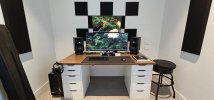Some additions:
- I know of 2 people who reported this for the KH750 (not more), and zero in context of KH150 or KH120II.
- Found the link to the discussion about this topic: https://www.audiosciencereview.com/...-monitor-alignment.17902/page-35#post-1426050 (Posts 684 to 688, @audafreak)
- I personally use a digital connection from my RME UCX II to my 2 KH750s, but, for the peace of mind only, i configured Roon to resample everything to 48khz to take the Neumann resampler out of the equation. But like i said, i don´t really hear a difference. It is hard/impossible to make a valid test, though.
Currently I use UCX2 via digital to Neumann. Before I used different HW ADI2 DAC FS via analog to Neuman. They are both connected currently but 99% use digi UCX2 with ARC USB.Thank you. I am also picking up RME UCX II. Don't need so many I/O's really, but I want access to TotalMix and want something better than Babyface. As for the connection to monitors, considering how trustworthy Neumann is, I think it's safe to just follow their recommendation and go with SPDIF coax.
Before I resampled everything in JRiver to 48kHz like DJBonoBobo but tried to resample only below 44 and above 192 and it seems trebles are more pronounced. So this is setup I use currently :
partial resampling
UCX2
- front KH750+2xKH80 spdif out
- surround 2xKH80 analog out
7.1 input from Jriver downmixed manually in Totalmix to 4.0, of course Lfe to FL/FR, BL/BR with some crosstalk to SL/SR.
ADI2 DAC is better dac then UCX2 so I would also recommend digital way from UCX2. Or connect both and you will see/hear. But if you want to use analog, disconnect SPDIF because this input has priority.

